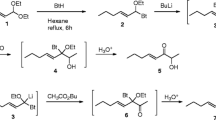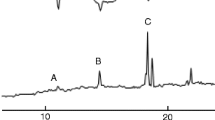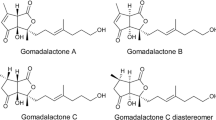Abstract
We identified, synthesized, determined the diel periodicity of release, and tested the bioactivity of components of the male-produced sex pheromone of Hedypathes betulinus (Coleoptera: Cerambycidae: Lamiinae). Gas chromatographic-mass spectrometric analysis of headspace volatiles from adult beetles showed three male-specific compounds, which were identified as (E)-6,10-dimethyl-5,9-undecadien-2-yl acetate (major component), (E)-6,10-dimethyl-5,9-undecadien-2-one (geranylacetone), and (E)-6,10-dimethyl-5,9-undecadien-2-ol. Release of these chemicals was dependent on time of the photoperiod and presence of the host plant. Pheromone release took place primarily during the photophase, with maximum release occurring between 4 and 6 hr after the onset of photophase. The amount of pheromone released by males was much greater when they were in the presence of their host plant than when they were not. In Y-tube olfactometer tests, a ternary mixture of the compounds was attractive to female beetles, although the individual compounds were not attractive by themselves. Addition of volatiles from the host plant greatly increased the attractiveness of the ternary pheromone mixture and of the major pheromone component alone.




Similar content being viewed by others
References
Allison, J. D., Borden, J. H., and Seybold, S. J. 2004. A review of the chemical ecology of the cerambycidae (Coleoptera). Chemoecology 14:123–150.
Ayres, M., Ayres, M., Jr, Ayres, D. L., and Santos, A. S. 2003. BioEstat3.0, Aplicações estatística nas áreas das ciências biológicas e médicas. Sociedade Civil Mamirauá, Belém.
Baker, T. C., and Linn, C. E. 1984. Wind tunnels in pheromone research, pp. 75–110, in H. E. Hummel and T. H. Miller (eds.). Techniques in Pheromone Research. Springer-Verlag, New York, USA.
Boyer, F.-D., Malosse, C., Zagatti, P., and Einhorn, J. 1997. Identification and synthesis of vesperal, the female sex pheromone of the longhorn beetle Vesperus xatari. Bull. Soc. Chim. Fr. 134:757–764.
Byers, J. A., Birgersson, G., Lofgvist, J., Appelgren, M., and Bergstrom, G. 1990. Isolation of pheromone synergists of bark beetle, Pityogenes chalcographus, from complex insect-plant odors by fractionation and subtractive-combination bioassay. J. Chem. Ecol. 16:861–876.
Cassanello, A. M. L. 1993. Ciclo de vida e aspectos morfológicos de Hedypathes betulinus (Klug, 1825) (Coleoptera, Cerambycidae, Lamiinae), broca-da-erva-mate (Ilex paraguariensis St. Hil.), pp. 59, Dissertação de Mestrado, UFPR, Curitiba.
Deng, J. Y., Wei, H. Y., Huang, Y. P., and Du, J. W. 2004. Enchancement of attraction to sex pheromone of Spodoptera exigua by volatile compounds produced by host plants. J. Chem. Ecol. 30:2037–2045.
Dickens, J. C., Jang, E. B., Light, D. M., and Alford, A. R. 1990. Enhancement of insect pheromone responses by green leaf volatiles. Naturwissenchaften 77:29–31.
Dickens, J. C., Visser, J. H., and Van Der Pers, J. M. C. 1993. Detection and deactivation of pheromone and plant odor components by the beet armyworm, Spodoptera exigua (Hubner) (Lepidoptera: Noctuidae). J. Insect Physiol. 39:503–516.
Fonseca, M. G., and Zarbin, P. H. G. 2009. Mating behaviour and evidence for sex-specific pheromones in Hedypathes betulinus (Coleoptera: Cerambycidae: Lamiinae). J. Appl. Entomol. 133:695–701.
Ginzel, M. D., and Hanks, L. M. 2005. Role of host plant volatiles in mate location for three species of longhorned beetle. J. Chem. Ecol. 31:213–217.
Hanks, L. M. 1999. Influence of the larval host plant on reproductive strategies of cerambycid beetles. Annu. Rev. Entomol. 44:483–505.
Hanks, L. M., Millar, J. G., Moreira, J. A., Barbour, J. D., Lacey, E. S., Mcelfresh, J. S., Reuter, F. R., and Ray, A. M. 2007. Using generic pheromone lures to expedite identification of aggregation pheromones for the cerambycid beetles Xylotrechus nauticus, Phymatodes lecontei, and Neoclytus modestus modestus. J. Chem. Ecol. 33:889–907.
Ibeas, F., Díez, J. J., and Pajares, J. A. 2008. Olfactory sex attraction and mating behaviour in the pine Sawyer Monochamus galloprovincialis (Coleoptera: Cerambycidae). J. Insect. Behav. 21:101–110.
Lacey, E. S., Moreira, J. A., Millar, J. G., and Hanks, L. M. 2008. A male-produced aggregation pheromone blend consisting of alkanediols, terpenoids, and an aromatic alcohol from the cerambycid beetle Megacyllene caryae. J. Chem. Ecol. 34:408–417.
Landolt, P. J., Reed, H. C., and Heath, R. R. 1992. Attraction of female papaya fruit fly (Diptera: Tephritidae) to male pheromone and host fruit. Environ. Entomol. 21:1154–1159.
Leal, W. S., Bento, J. M. S., Vilela, E. F., and Della Lucia, T. M. C. 1994. Female sex pheromone of the longhorn beetle Migdolus fryanus Westwood: N- (2′S)-methylbutanoyl 2-methylbutylamine. Experentia 50:853–856.
Leal, W. S., Zarbin, P. H. G., Wojtasek, H., and Ferreira, J. T. 1999. Biosynthesis of scarab beetle pheromones-Enantioselective 8-hydroxylation of fatty acids. Eur. J. Biochem. 259:175–180.
Liendo, C., Morillo, F., Sánchez, P., and Muñoz, W. 2005. Olfactory behavior and electroantennographic responses of the cocoa beetle, Steirastoma breve (Coleoptera: Cerambycidae). Fla. Entomol. 88:117–122.
Nakamuta, K., Leal, W. S., Nakashima, T., Tokoro, M., Ono, M., and Nakanishi, M. 1997. Increase of trap catches by a combination of male sex pheromone and floral attractant in longhorn beetle. J. Chem. Ecol. 23:1635–1640.
Nehme, M. E., Keena, M. A., Zhang, A., Baker, T. C., and Hoover, K. 2009. Attraction of Anoplophora glabripennis to male-produced pheromone and plant volatiles. Environ. Entomol. 38:1745–1755.
Nehme, M. E., Keena, M. A., Zhang, A., Baker, T. C., Xu, Z., and Hoover, K. 2010. Evaluating the use of male-produced pheromone components and plant volatiles in two trap designs to monitor Anoplophora glabripennis. Environ. Entomol. 39:169–176.
Phillips, T. W., West, J. R., Foltz, J. L., Silverstein, R. M., and Lanier, G. N. 1984. Aggregation pheromone of the deodar weevil, Pissodes nemeorensis (Coleoptera: Curculionidae): isolation and activity of grandisol and grandisal. J. Chem.Ecol. 10:1417–1423.
Ray, A. M., Lacey, E. S., and Hanks, L. M. 2006. Predicted taxonomic patterns in pheromone production by longhorned beetles. Naturwissenschaften 93:543–550.
Ray, A. M., Millar, J. G., McElfresh, J. S., Swift, I. P., Barbour, J. D., and Hanks, L. M. 2009. Male-produced aggregation pheromone of the cerambycid beetle Rosalia funebris. J. Chem. Ecol. 35:96–103.
Reddy, G. V. P., and Guerrero, A. 2000. Behavioral responses of the diamond-back moth, Plutella xylostella, to green leaf volatiles of Brassica oleracea subsp. Capitata. J. Agric. Food. Chem. 48:6025–6029.
Reddy, G. V. P., and Guerrero, A. 2004. Interactions of insect pheromones and plant semiochemicals. Trends Plant Sci. 9:253–261.
Reddy, G. V.P., Fettköther, R., Noldt, U., and Dettner, K. 2005. Capture of female Hylotrupes bajulus as influenced by trap type and pheromone blend. J. Chem. Ecol. 31:2169–2177.
Rodstein, J., McElfresh, J. S., Barbour, J. D., Ray, A. M., Hanks, L. M., and Millar, J. G. 2009. Identification and synthesis of a female-produced sex pheromone for the cerambycid beetle Prionus californicus. J. Chem. Ecol. 35:590–600.
Silk, P. J., Sweeney, J., and Wu, J. 2007. Evidence for a male-produced pheromone in Tetropium fuscum (F.) and Tetropium cinnamopterum (Kirby) (Coleoptera: Cerambycidae). Naturwissenschaften 94:697–701.
Yang, Z., Bengtsson, M., and Witzgall, P. 2004. Host plant volatiles synergize response to sex pheromone in codling moth, Cydia pomonella. J. Chem. Ecol. 30:619–629.
Zarbin, P. H. G. 2001. Extração, isolamento e identificação de substâncias voláteis de insetos, pp. 45–50, in E. F. Vilela and M. C. Della-Lucia (eds.). Fermônio de Insetos: Biologia, Química e Emprego no Manejo de Pragas, 2nd ed. Holos, Ribeirão Preto, Brasil.
Zarbin, P. H. G., Cruz, W. D., and Ferreira, J. T. B. 1998. Stereospecific synthesis of two isomers of (4,8)-dimethyldecanal: The aggregation pheromone of Tribolium spp. J. Braz. Chem. Soc. 9:511–513.
Zarbin, P. H. G., Ferreira, J. T. B., and Leal, W. S. 1999. Metodologias gerais empregadas no isolamento e identificação estrutural de feromônio de insetos. Quím. Nova 22:263–268.
Zarbin, P. H. G., Arrigoni, E. B., Reckziegel, A., Moreira, J. A., Baraldi, P. T., and Vieira, P. C. 2003. Identification of male-specific chiral compound from the sugarcane weevil Sphenophorus levis. J. Chem. Ecol. 29:377–386.
Zhang, Q. H., and Schlyter, F. 2003. Redundancy, synergism, and active inhibitory range of non-host volatiles in reducing pheromone attraction in European spruce bark beetle Ips typographus. Oikos 101:299–310.
Zhang, A., Oliver, J. E., Aldrich, J. R., Wang, B., and Mastro, V. C. 2002. Stimulatory beetle volatiles for the Asian longhorned beetle, Anoplophora glabripennis (Motschulaky). Z. Naturforsh. 57C:553–558.
Zhang, A. J., Oliver, J. E., Chauhan, K., Zhao, B. G., Xia, L. Q., and Xu, Z. C. 2003. Evidence for contact sex recognition pheromone of the Asian longhorned beetle, Anoplophora glabripennis (Coleoptera: Cerambycidae). Naturwissenschaften 90:410–413.
Acknowledgments
We thank VIER farm for providing access to their fields for insect collection. This research was supported by the Conselho Nacional de Desenvolvimento Científico e Tecnológico (CNPq, Brazil) and Instituto Nacional de Ciências e Tecnologia de Semioquímicos na Agricultura. We also thank Dr. Jeffrey R. Aldrich (USDA-ARS, Beltsville, MD/USA) for revising the draft version of the manuscript.
Author information
Authors and Affiliations
Corresponding author
Rights and permissions
About this article
Cite this article
Fonseca, M.G., Vidal, D.M. & Zarbin, P.H.G. Male-Produced Sex Pheromone of the Cerambycid Beetle Hedypathes betulinus: Chemical Identification and Biological Activity. J Chem Ecol 36, 1132–1139 (2010). https://doi.org/10.1007/s10886-010-9850-y
Received:
Revised:
Accepted:
Published:
Issue Date:
DOI: https://doi.org/10.1007/s10886-010-9850-y




